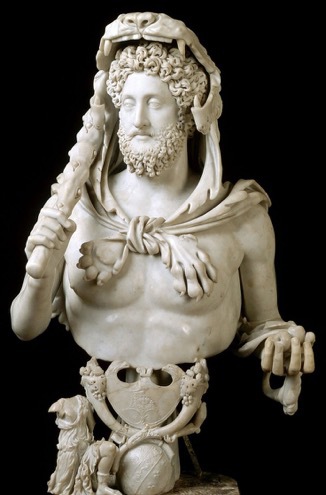Commodus as Hercules
Title
Commodus as Hercules
Date
180-193 AD, Antonine Period
Artist or Workshop
Unknown
Materials
Marble
Height of the work
133 cm tall
Provenience
Esquiline, Rome
Current Location
Capitoline Museum of Rome, Italy
Description and Significance
Description:
Commodus, rendered in the guise of Hercules in a marble bust, is depicted as a young, muscular man, who is mostly nude. He dawns the skin of a lion as his headdress, with the deflated beast’s front paws secured in a tight knot across his chest. His hair consists of many coiled curls, as does his beard. He is wielding a club over his right shoulder and holding small apples in his left hand. Two women, depicted in much smaller proportion than him, once held up the shield below his chest; however, damage over time leaves only one headless woman on Commodus’ right side. Aside from this, the statue is predominately held up by a small sphere below the shield and in good condition.
Significance:
Commodus, who became Emperor at age 20, was known as one of the most pompous and reckless emperors of the Roman Empire; in fact, it was even rumored that he murdered his own father. In this depiction of the violent young leader, he is rendered as haughty and disdainful, with sleepy-looking eyes and mop-like hair. His slightly parted mouth alludes to how Alexander was depicted. Commodus in the guise of Hercules renders the god-like way in which the Emperor wished to be remembered. Two militaristic women were originally depicted holding the shield of Commodus to showcase his dedication to campaigning and power through military force. Though his face is personalized, his body and garments are not. His heroism is shown through his nudity and his garments obviously allude to Hercules. The most obvious example of this is the lion skin draped over his head and shoulders, which Alexander was known to wear in portraiture as well. The apples in his hand represent the apples of Hercules’ labors; Hercules worked to finish his labors in order to become a real god. In this way, Commodus renders his own self-defined path to becoming a deity. Lastly, the two cornucopias represent abundance, indicating his wealth as a leader.
Commodus, rendered in the guise of Hercules in a marble bust, is depicted as a young, muscular man, who is mostly nude. He dawns the skin of a lion as his headdress, with the deflated beast’s front paws secured in a tight knot across his chest. His hair consists of many coiled curls, as does his beard. He is wielding a club over his right shoulder and holding small apples in his left hand. Two women, depicted in much smaller proportion than him, once held up the shield below his chest; however, damage over time leaves only one headless woman on Commodus’ right side. Aside from this, the statue is predominately held up by a small sphere below the shield and in good condition.
Significance:
Commodus, who became Emperor at age 20, was known as one of the most pompous and reckless emperors of the Roman Empire; in fact, it was even rumored that he murdered his own father. In this depiction of the violent young leader, he is rendered as haughty and disdainful, with sleepy-looking eyes and mop-like hair. His slightly parted mouth alludes to how Alexander was depicted. Commodus in the guise of Hercules renders the god-like way in which the Emperor wished to be remembered. Two militaristic women were originally depicted holding the shield of Commodus to showcase his dedication to campaigning and power through military force. Though his face is personalized, his body and garments are not. His heroism is shown through his nudity and his garments obviously allude to Hercules. The most obvious example of this is the lion skin draped over his head and shoulders, which Alexander was known to wear in portraiture as well. The apples in his hand represent the apples of Hercules’ labors; Hercules worked to finish his labors in order to become a real god. In this way, Commodus renders his own self-defined path to becoming a deity. Lastly, the two cornucopias represent abundance, indicating his wealth as a leader.
References
Musei Capitolini
Hekster, Olivier. "Propagating power. Hercules as an example for second-century emperors." Herakles and Hercules. Exploring a Graeco-Roman Divinity (2005): 205-21.
Speidel, Michael P. "Commodus the God-Emperor and the army." The Journal of Roman Studies 83 (1993): 109-114.
Hekster, Olivier. "Propagating power. Hercules as an example for second-century emperors." Herakles and Hercules. Exploring a Graeco-Roman Divinity (2005): 205-21.
Speidel, Michael P. "Commodus the God-Emperor and the army." The Journal of Roman Studies 83 (1993): 109-114.
Contributor
Charlotte Myers
Citation
Unknown, “Commodus as Hercules,” Digital Portrait "Basket" - ARTH488A "Ancient Mediterranean Portraiture", accessed June 6, 2025, http://classicalchopped.artinterp.org/omeka/items/show/44.
Item Relations
This item has no relations.

